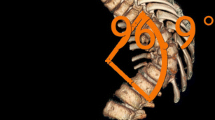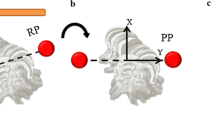Abstract
Purpose
Therapeutic decisions for congenital scoliosis rely on Cobb angle measurements on consecutive radiographs. There have been no studies documenting the variability of measuring the Cobb angle using 3D-CT images in children with congenital scoliosis. The purpose of this study was to compare the reliability and measurement errors using X-ray images and those utilizing 3D-CT images.
Materials and methods
The X-ray and 3D-CT images of 20 patients diagnosed with congenital scoliosis were used to assess the reliability of the digital 3D-CT images for the measurement of the Cobb angle. Thirteen observers performed the measurements, and each image was analyzed by each observer twice with a minimum interval of 1 week between measurements. The analysis of intraobserver variation was expressed as the mean absolute difference (MAD) and standard deviation (SD) between measurements and the intraclass correlation coefficient (IaCC) of the measurements. In addition, the interobserver variation was expressed as the MAD and interclass correlation coefficient (IeCC).
Results
The average MAD and SD was 4.5° and 3.2° by the X-ray method and 3.7° and 2.6° by the 3D-CT method. The intraobserver and interobserver intraclass ICCs were excellent in both methods (X-ray: IaCC 0.835–0.994 IeCC 0.847, 3D-CT: IaCC 0.819–0.996 IeCC 0.893). There was no significant MAD difference between X-ray and 3D-CT images in measuring each type of congenital scoliosis by each observer.
Conclusions
Results of Cobb angle measurements in patients with congenital scoliosis using X-ray images in the frontal plane could be reproduced with almost the same measurement variance (3°–4° measurement error) using 3D-CT images. This suggests that X-ray images are clinically useful for assessing any type of congenital scoliosis about measuring the Cobb angle alone. However, since 3D-CT can provide more detailed images of the anterior and posterior components of malformed vertebrae, the volume of information that can be obtained by evaluating them has contributed greatly to the development of strategies for the surgical treatment of congenital scoliosis.

Similar content being viewed by others
References
Adam CJ, Izatt MT, Harvey JR, Askin GN (2005) Variability in Cobb angle measurements using reformatted computerized tomography scans. Spine 30:1664–1669
Aubin CE, Bellefleur C, Joncas J, de Lanauze D, Kadoury S, Blanke K, Parent S, Labelle H (2011) Reliability and accuracy analysis of a new semiautomatic radiographic measurement software in adult scoliosis. Spine 36:E780–E790
Dutton KE, Jones TJ, Slinger BS, Scull ER, O’Connor J (1989) Reliability of the Cobb angle index derived by traditional and computer assisted methods. Australas Phys Eng Sci Med 12:16–23
Jeffries BF, Tarlton M, De Smet AA, Dwyer SJ 3rd, Brower AC (1980) Computerized measurement and analysis of scoliosis: a more accurate representation of the shape of the curve. Radiology 134:381–385
Shea KG, Stevens PM, Nelson M, Smith JT, Masters KS, Yandow S (1998) A comparison of manual versus computer-assisted radiographic measurement. Intraobserver measurement variability for Cobb angles. Spine 23:551–555
Stokes IA, Aronsson DD (2006) Computer-assisted algorithms improve reliability of King classification and Cobb angle measurement of scoliosis. Spine 31:665–670
Tanure MC, Pinheiro AP, Oliveira AS (2010) Reliability assessment of Cobb angle measurements using manual and digital methods. Spine J 10:769–774
Zhang J, Lou E, Shi X, Wang Y, Hill DL, Raso JV, Le LH, Lv L (2010) A computer-aided Cobb angle measurement method and its reliability. J Spinal Disord Tech 23:383–387
Qiao J, Liu Z, Xu L, Wu T, Zheng X, Zhu Z, Zhu F, Qian B, Qiu Y (2012) Reliability analysis of a smartphone-aided measurement method for the Cobb angle of scoliosis. J Spinal Disord Tech 25:E88–E92
Facanha-Filho FA, Winter RB, Lonstein JE, Koop S, Novacheck T, L’Heureux EA Jr, Noren CA (2001) Measurement accuracy in congenital scoliosis. J Bone Joint Surg Am 83A:42–45
Loder RT, Urquhart A, Steen H, Graziano G, Hensinger RN, Schlesinger A, Schork MA, Shyr Y (1995) Variability in Cobb angle measurements in children with congenital scoliosis. J Bone Joint Surg Br 77:768–770
Geijer H, Beckman K, Jonsson B, Andersson T, Persliden J (2001) Digital radiography of scoliosis with a scanning method: initial evaluation. Radiology 218:402–410
Geijer H, Verdonck B, Beckman KW, Andersson T, Persliden J (2003) Digital radiography of scoliosis with a scanning method: radiation dose optimization. Eur Radiol 13:543–551
Gross C, Gross M, Kuschner S (1983) Error analysis of scoliosis curvature measurement. Bull Hosp Jt Dis Orthop Inst 43:171–177
Acknowledgments
No funds were received in support of this work. No benefits in any form have been or will be received from commercial parties related directly or indirectly to the subject of this manuscript. This work is a result of efforts by the Chest Wall and Spinal Deformity Study Group (CWSDSG). We sincerely express our appreciation to Ms. Tricia St. Hilaire for her contribution to this project.
Author information
Authors and Affiliations
Corresponding author
Ethics declarations
Conflict of interest
The authors have no financial conflicts of interest.
Rights and permissions
About this article
Cite this article
Tauchi, R., Tsuji, T., Cahill, P.J. et al. Reliability analysis of Cobb angle measurements of congenital scoliosis using X-ray and 3D-CT images. Eur J Orthop Surg Traumatol 26, 53–57 (2016). https://doi.org/10.1007/s00590-015-1701-7
Received:
Accepted:
Published:
Issue Date:
DOI: https://doi.org/10.1007/s00590-015-1701-7




